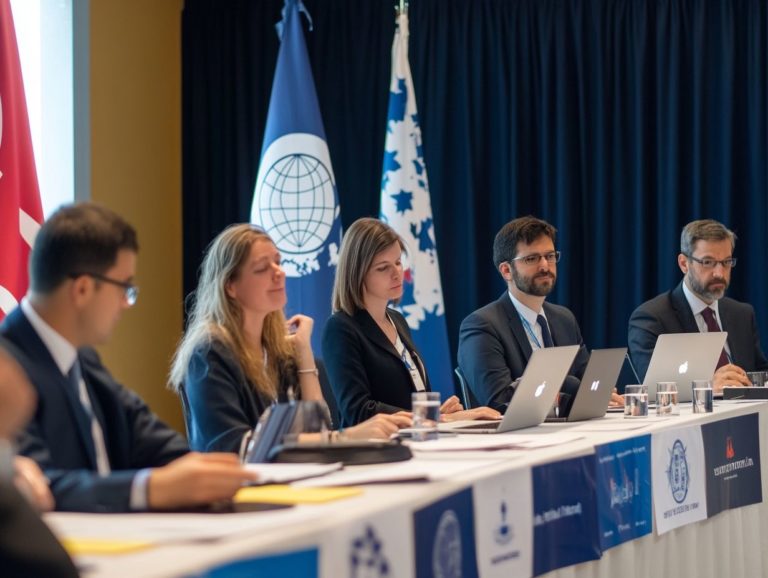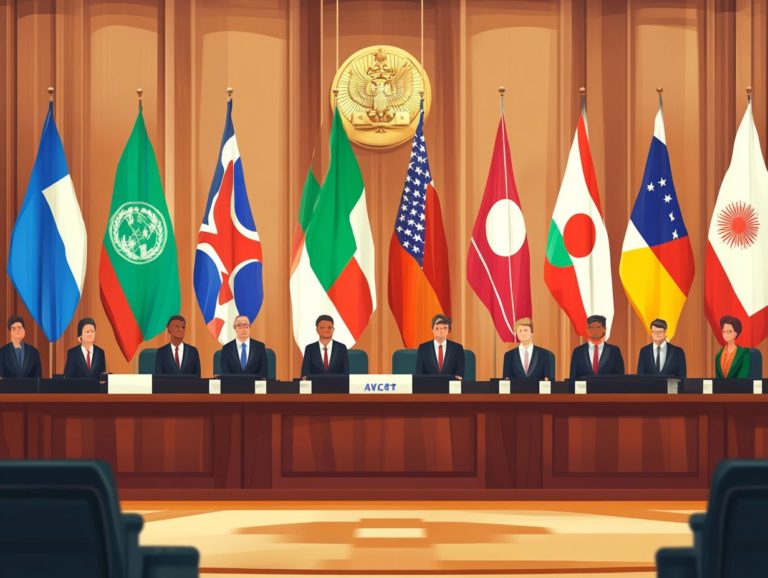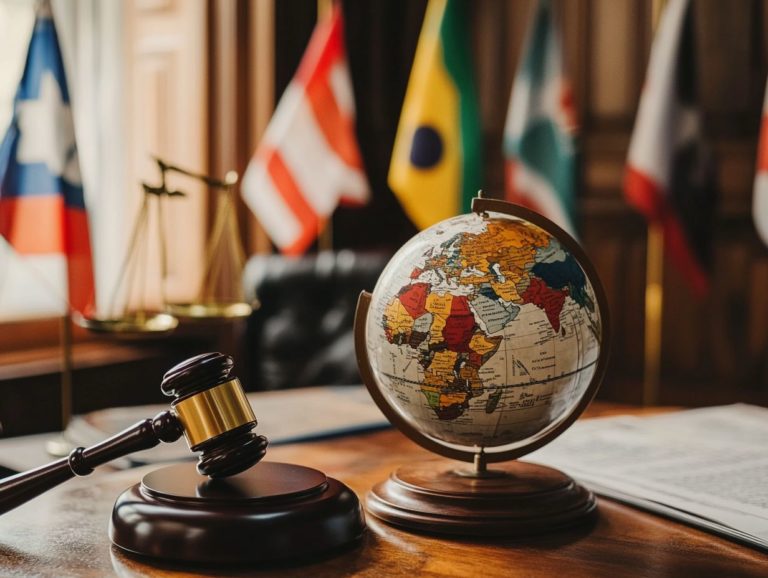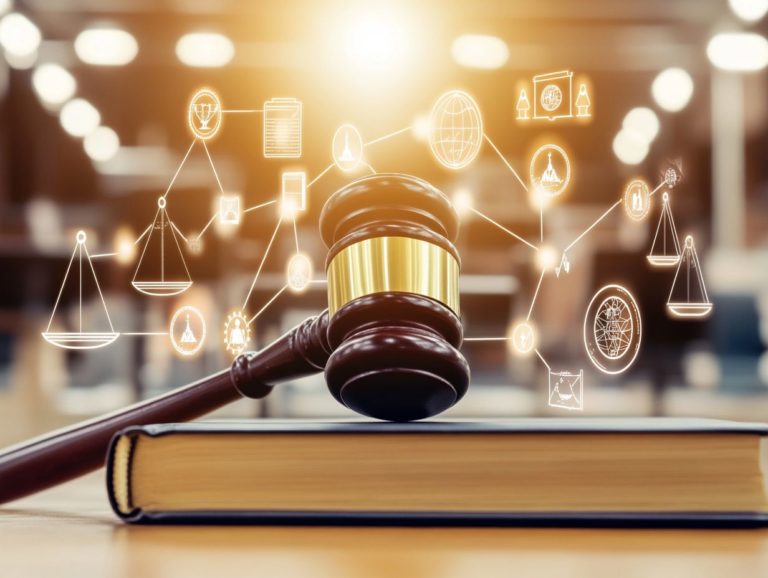The Intersection of IP Law and Human Rights
Intellectual property (IP) law is essential for protecting creativity and innovation. Its intersection with human rights raises critical questions you should consider.
This piece delves into the fundamentals of IP rights, exploring the various types and protections they offer. It emphasizes the importance of human rights within this legal framework.
By examining real-world issues like access to essential medicines and the safeguarding of traditional knowledge, you ll gain insight into the challenges of balancing these crucial concerns.
We also explore the roles of international organizations, such as the United Nations and the World Intellectual Property Organization, in navigating these complexities.
Join us on this journey as we unravel the intricate relationship between IP law and human rights. Discover its profound implications for society.
Contents
- Key Takeaways:
- The Basics of Intellectual Property Law
- The Importance of Human Rights in IP Law
- Examples of Human Rights Issues in IP
- The Role of International Organizations in Balancing IP and Human Rights
- Frequently Asked Questions
- What is the intersection of IP law and human rights?
- Why is the intersection of IP law and human rights important?
- What are some examples of IP laws that can impact human rights?
- How can IP laws be used to promote human rights?
- What are some challenges in addressing the intersection of IP law and human rights?
- How can individuals and organizations support the protection of human rights in the context of IP law?
Key Takeaways:
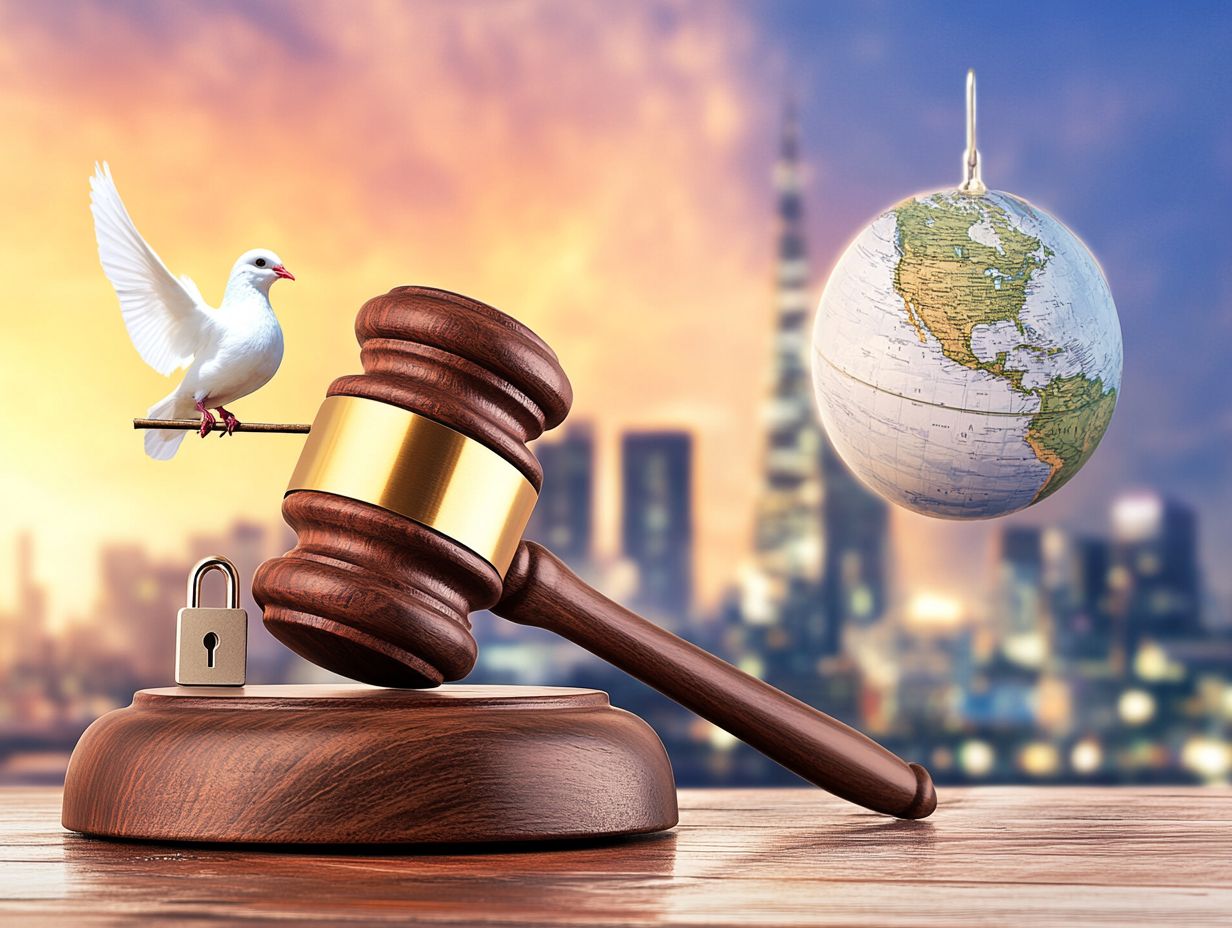
IP law and human rights are closely linked. Protecting IP rights can impact people s access to medicines and preserving traditional knowledge. Organizations like the UN and WIPO work to create balance. Recognizing human rights in IP law promotes fairness and justice for all.
The Basics of Intellectual Property Law
Intellectual Property Law is a crucial framework designed to protect the rights of creators and innovators. This ensures their contributions be it inventions, artistic works, or branding are acknowledged and safeguarded.
In today s interconnected world, understanding these laws is paramount. They encompass patents, copyrights, and trade secrets, which are vital for both individuals and businesses navigating global trade agreements and the ever-evolving realm of innovation.
Overview of IP Rights
IP rights are the cornerstone of Intellectual Property Law. They grant you the legal protection needed to safeguard your creations and ensure you can reap the benefits of your inventions and works.
These rights cover a range of aspects, including:
- Patents that secure your inventions,
- Copyrights that shield your artistic and literary endeavors,
- Trademarks that help distinguish your products and services.
IP rights are essential not only for promoting innovation but also for supporting social justice and equitable access to knowledge.
By embracing the principles established in the Universal Declaration of Human Rights, IP rights enable you to engage in cultural life and share in scientific progress.
This alignment reflects a commitment to fairness. It allows diverse voices to thrive while affirming the importance of recognizing and respecting the contributions of creators like you.
Types of IP and Their Protection
The world of Intellectual Property is complex and varied, offering protections essential for safeguarding your creations. You have patents to protect your inventions, copyrights for your artistic works, trademarks that represent your brand, and trade secrets information that gives your business a competitive edge.
Each of these legal mechanisms serves a unique purpose. Patents incentivize technological advancements by granting you exclusive rights for a limited time, while copyrights ensure you retain control over your original works, nurturing a vibrant cultural landscape.
Trademarks build trust and reliability among consumers, allowing you to establish a strong identity in competitive markets. Meanwhile, trade secrets enable you to shield vital information from competitors, encouraging a culture of innovation.
By grasping these protections, you can adeptly navigate the challenges inherent in innovation and economic development, paving the way for a more resilient economy.
The Importance of Human Rights in IP Law
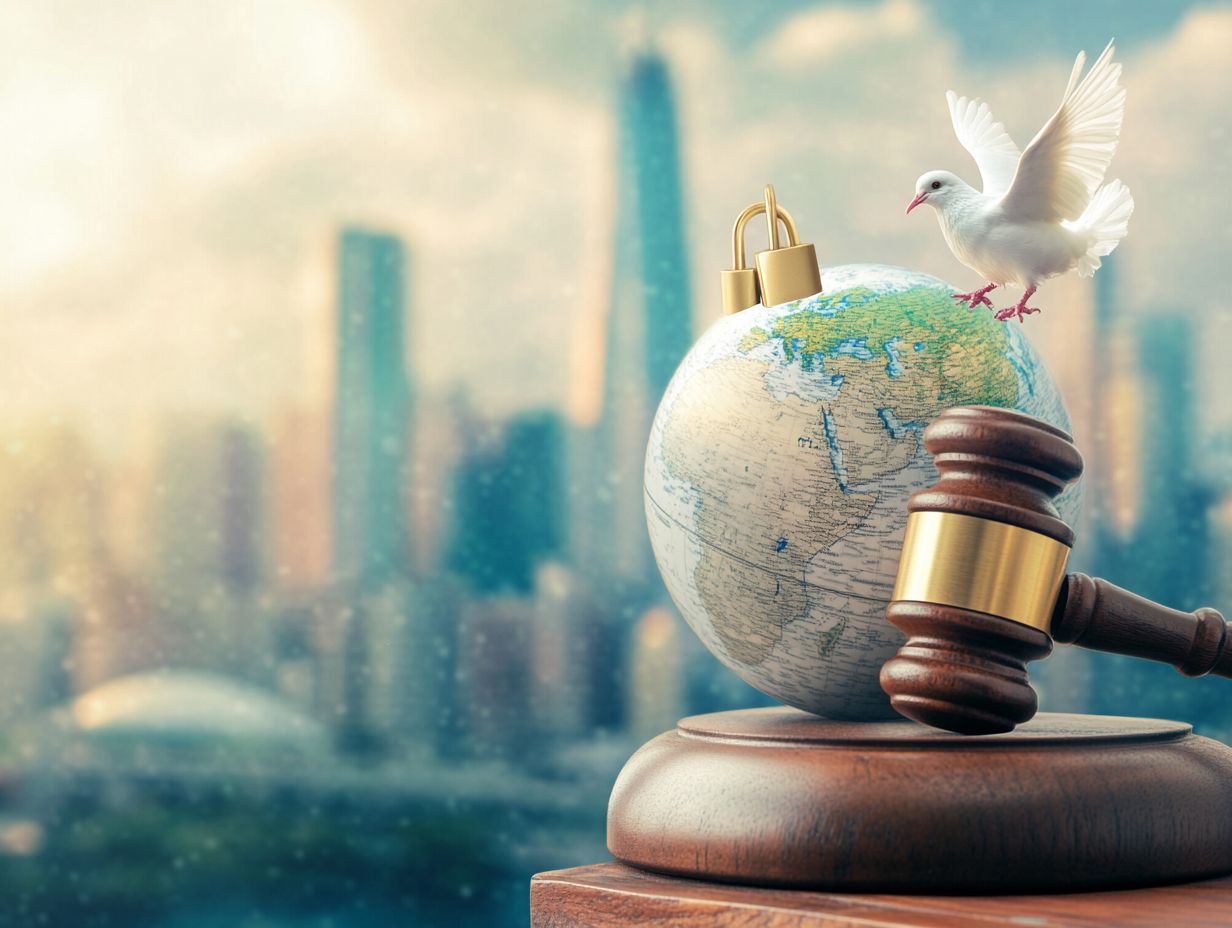
The intersection of human rights and Intellectual Property Law underscores the essential need for a balanced approach. This approach nurtures innovation and creativity while safeguarding individuals’ rights to access vital resources, such as medicines and knowledge.
Striking this balance is crucial for cultivating a just society where IP rights do not overshadow fundamental human rights. They should work in harmony to promote equitable access and foster social justice for everyone.
Recognizing and Protecting Human Rights in IP
Recognizing and safeguarding human rights within the realm of Intellectual Property is crucial for ensuring that everyone enjoys equitable access to health, education, and cultural resources.
By aligning IP laws with international human rights frameworks, such as the Universal Declaration of Human Rights, you can help create an environment where knowledge and creativity thrive.
This alignment opens the door to inclusive policies that prioritize access over exclusivity, particularly benefiting those in developing countries.
When IP laws protect rights, they not only shield creators but also enhance your ability to engage with cultural and educational materials.
This fosters a richer communal knowledge base, ultimately propelling innovation and societal progress, especially in areas where resources are limited.
Examples of Human Rights Issues in IP
Human rights issues tied to Intellectual Property manifest in multiple dimensions, especially when it comes to access to essential medicines and the protection of traditional knowledge.
These challenges underscore the pressing necessity for a more equitable IP framework one that balances the rights of creators with the public’s fundamental right to access vital resources.
Access to Essential Medicines
Access to essential medicines is a critical human rights issue that demands immediate attention, often blocked by stringent patent protections that favor pharmaceutical companies over public health.
These protections block access to life-saving medications, especially for individuals in low- and middle-income countries. Consider the astronomical prices for essential antiretrovirals used in HIV treatment; these costs often leave many without the medications they desperately need.
This situation highlights the ongoing struggle between intellectual property rights and the pressing demand for affordable healthcare. Exploring alternative solutions, such as compulsory licensing, means governments can allow others to make cheaper copies of patented drugs.
Such a model enhances access to vital medicines while still respecting intellectual property rights, ultimately promoting a more equitable healthcare landscape for all.
Protection of Traditional Knowledge
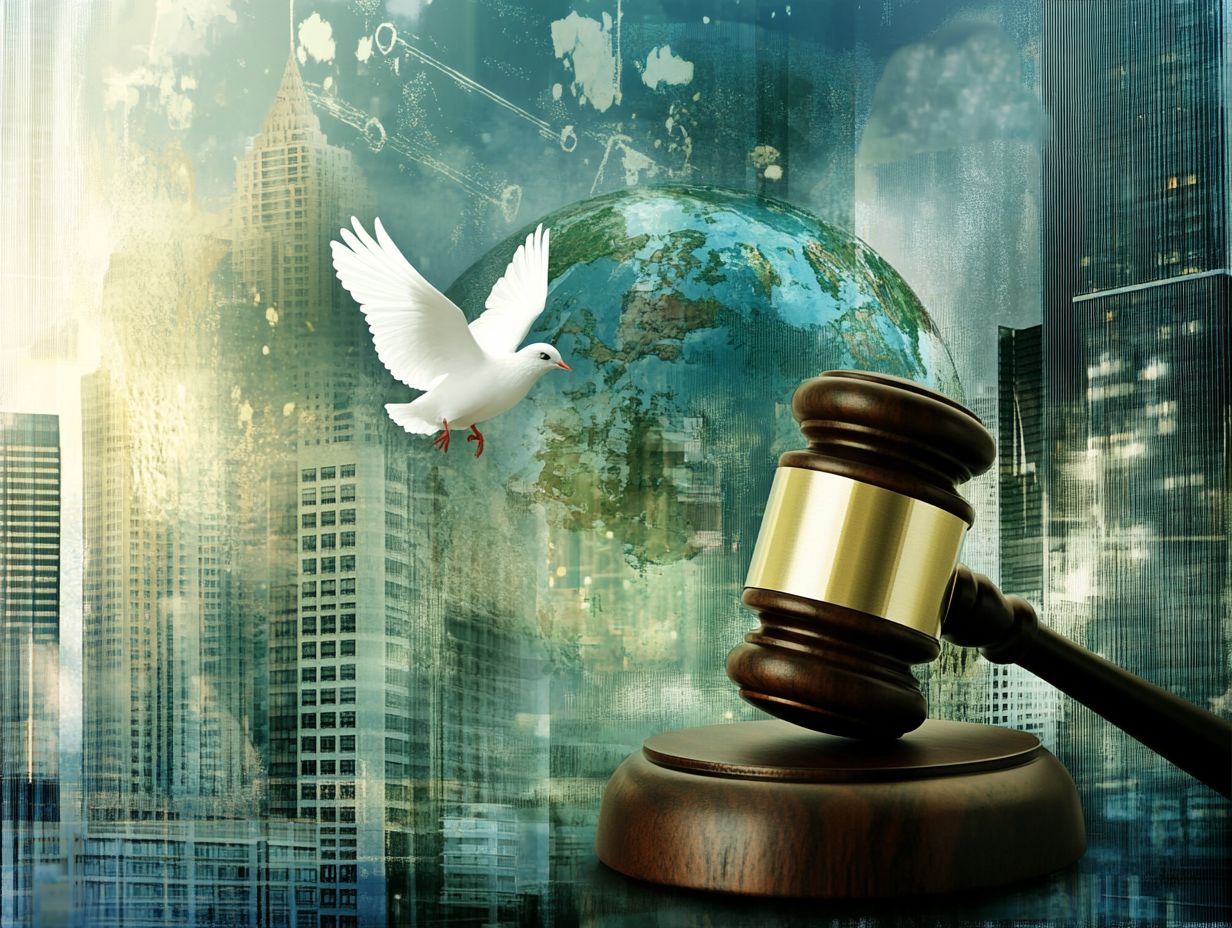
The protection of traditional knowledge has become a pivotal element of Intellectual Property Law, especially when it comes to promoting social justice and acknowledging the invaluable contributions of indigenous communities. This framework is crucial not just for safeguarding unique cultural practices, but also for enabling local populations against unfair exploitation.
Empirical evidence from various case studies, such as the successful protection of medicine derived from indigenous plants in the Amazon, showcases how legal recognition can cultivate respect for community rights.
Initiatives that weave traditional knowledge into biodiversity conservation strategies further highlight its significance in advancing environmental sustainability.
By honoring and protecting these essential cultural elements, IP frameworks ensure that innovative knowledge is preserved for future generations, benefiting both cultural heritage and societal equity.
The Role of International Organizations in Balancing IP and Human Rights
International organizations are essential in balancing the interests of Intellectual Property rights with human rights, utilizing frameworks like the TRIPS Agreement and initiatives spearheaded by the United Nations and the World Intellectual Property Organization (WIPO).
These entities champion transparency and public participation, ensuring that IP laws effectively serve the needs of creators while respecting the rights of the public.
United Nations and World Intellectual Property Organization
The United Nations and the World Intellectual Property Organization (WIPO) join forces to create policies that promote innovation and protect human rights.
This collaboration underscores the necessity for frameworks that harmonize the protection of intellectual property (IP) rights with the fundamental rights of individuals, particularly regarding access to information and cultural expression.
Initiatives like the UN’s Sustainable Development Goals emphasize the crucial role that creativity and invention play in our world. WIPO s Development Agenda aims to ensure that IP systems actively foster social and economic development.
By engaging stakeholders at both global and local levels, these frameworks cultivate environments where innovation thrives while safeguarding the rights and dignity of every individual involved.
Efforts to Address Human Rights Concerns in IP Law
Addressing human rights in IP law is essential for transparency and public engagement, especially concerning the TRIPS Agreement (Trade-Related Aspects of Intellectual Property Rights).
By prioritizing these values, you can ensure that the rights and needs of individuals are effectively represented within IP frameworks.
Engaging civil society in discussions about access to medicines is vital, as the TRIPS Agreement sets minimum standards for IP protection that can significantly impact public health policies.
Implementing measures like impact assessments can enhance your ability to identify potential human rights implications. This enables a balance between the interests of IP holders and public welfare.
In this context, some countries are exploring ways to integrate human rights considerations more thoroughly into their IP regulations, fostering sustainable development and protecting the rights of marginalized communities.
Frequently Asked Questions
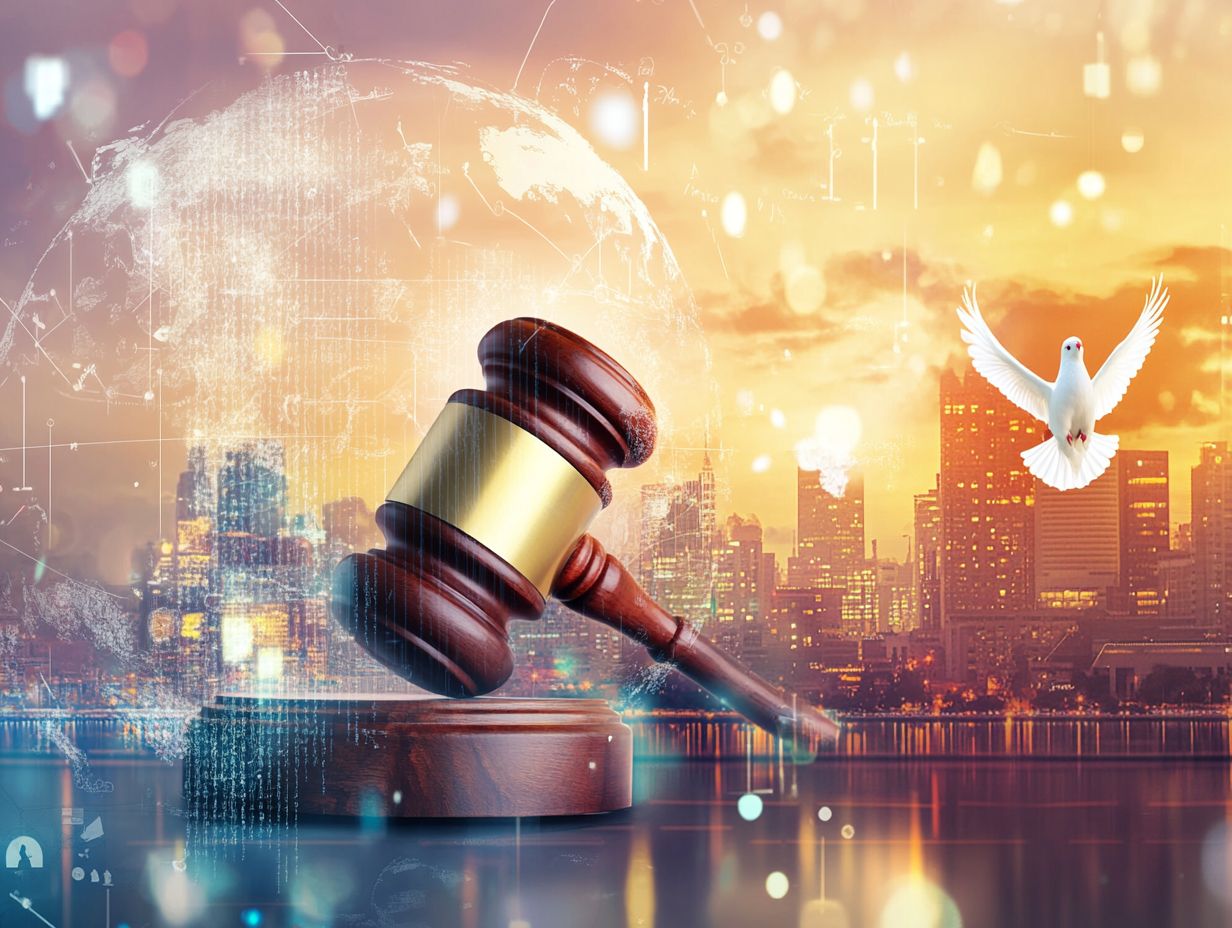
What is the intersection of IP law and human rights?
The intersection of IP law and human rights refers to the overlap between IP rights and human rights. It involves examining how IP laws and policies can impact or conflict with the protection of fundamental human rights, such as the right to access essential medicines, education, and cultural heritage, as well as exploring the intersection of IP litigation and fair use.
Why is the intersection of IP law and human rights important?
This intersection is important because it highlights the potential tension between protecting IP rights and ensuring that human rights are not violated. It raises questions about the balance between promoting innovation and protecting public interests like access to affordable medicines and cultural expression.
What are some examples of IP laws that can impact human rights?
Examples of IP laws impacting human rights include patents on life-saving drugs, copyright laws restricting access to educational resources, and trademark laws limiting the use of cultural symbols. These laws can directly affect the availability and affordability of essential goods and services, potentially violating human rights.
How can IP laws be used to promote human rights?
IP laws can promote human rights by implementing safeguards and exceptions that balance the protection of IP rights with public interests. For example, compulsory licensing in patent laws can ensure access to essential medicines, while fair use provisions in copyright laws can allow for the use of copyrighted material for educational and research purposes.
What are some challenges in addressing the intersection of IP law and human rights?
Challenges in this area include the complexity and evolving nature of IP laws, a lack of consensus on the definition and scope of human rights, and the influence of powerful industries in shaping IP policies. More collaboration and dialogue between IP and human rights experts are needed to find solutions that balance the interests of all stakeholders.
For further insights and engagement in this critical dialogue, consider exploring available resources on human rights and IP law.
How can individuals and organizations support the protection of human rights in the context of IP law?
You can make a difference! Support the protection of human rights today.
Educate yourself about how IP laws affect human rights. Advocate for laws that benefit everyone.
Get involved with initiatives that promote a fair IP system. Support organizations fighting for human rights.

